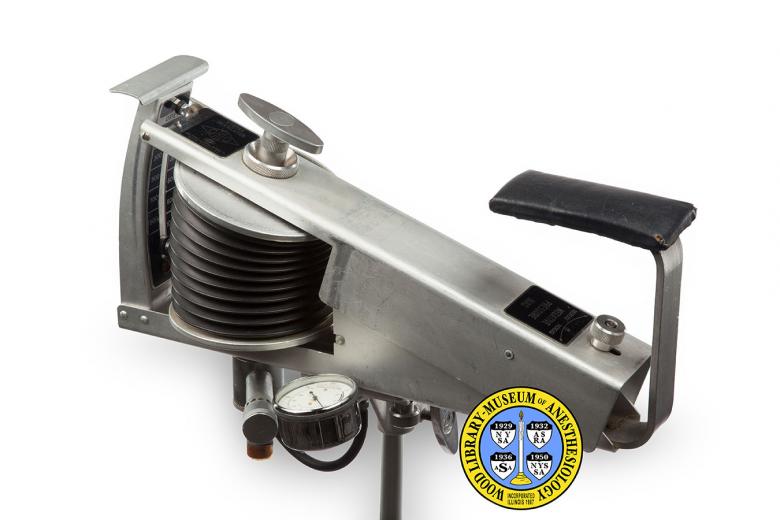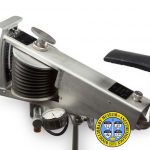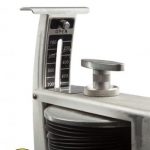Etsten Ventilator
Anesthesia can reduce a patient’s ability to breathe on his own. Anesthesiologists were on the front line in the development of equipment needed for ventilation and airway management because they are responsible for helping patients breathe effectively during anesthesia. Dr. Benjamin Etsten (1908-1987) introduced his manual ventilator in the mid-1950s, when a surge in the development of ventilation equipment was just beginning.
Prior to the advent of self-inflating resuscitation bags and modern ventilators, when anesthesiologists needed to manually ventilate a patient they used a rebreathing bag. The anesthesiologist had to estimate the volume of gas produced when his or her hand squeezed the bag. The desire for a device that would allow the anesthesiologist to deliver known volumes of gas to the patient first came to Dr. Etsten in 1941 while he was an exchange resident under Dr. Ralph Waters in Madison, Wisconsin. In the 1950s after becoming Professor and Chairman of the anesthesiology department at Tufts University he was able to begin testing his invention. It was manufactured by the Ohio Chemical and Surgical Equipment Company. To use the Etsten Ventilator the anesthesiologist would place his or her elbow on the padded rest and push the bellows down to the mark that corresponded with the desired volume. The volume was determined using a graphic device, called the Radford Nomogram, and was based on several patient variables, including body weight and respiratory rate.
Catalog Record: Etsten Ventilator
Access Key: akfv
Accession No.: 1984-04-27-1
Title: Etsten ventilator / [invented by Benjamin Etsten] ; Ohio Chemical and
Surgical Equipment Co.
Author: Etsten, Benjamin E., 1908-1987.
Corporate Author: Ohio Chemical and Surgical Equipment Company.
Publisher: Madison, Wisconsin : Ohio Chemical and Surgical Equipment Co., [1955-1965].
Physical Descript: 1 manual ventilator : metals, rubber, plastic, fabric ;
Note Type: General
Notes: Date range for year of manufacture is based on dates of publications in which
the Etsten Ventilator is and is not found in.
Note Type: Citation
Notes: Benjamin E. Etsten interviewed by Elliott V. Miller [DVD]. Park Ridge,
Illinois: Wood Library-Museum of Anesthesiology, 1983. Located in: The John W
Pender Collection of the Living History of Anesthesiology at the Wood
Library-Museum of Anesthesiology, Park Ridge, Illinois.
Note Type: Citation
Notes: Etsten Ventilator: Operation and Repair Manual. Madison, Wisconsin: Ohio
Chemical; [1956].
Note Type: Citation
Notes: Etsten B, Reynolds RN, Li TH. Studies on ventilation and circulation during
surgery using a volume displacement ventilator. Anesthesiology.
1958;19(1):100-101.
Note Type: Citation
Notes: Hunter AR. The basis of artificial ventilation of the lungs. Int Anesthesiol
Clin. 1967;5(1):167-168.
Note Type: Citation
Notes: Mushin WW, Rendell-Baker L, Thompson PW, Mapleson WW. Manual controlled
ventilation: manually-operated ventilators. In: Automatic Ventilation of the
Lungs. 2nd ed. Oxford: Blackwell Scientific Publications; 1969:763-764.
Note Type: Citation
Notes: Mushin WW, Rendell-Baker L, Thompson PW, Mapleson WW. Physiological aspects
of controlled respiration. Automatic Ventilation of the lungs. 3rd ed.
Oxford: Blackwell Scientific Publications; 1980:21-24.
Note Type: Citation
Notes: Sugai N. The centenary of the birth of Dr. Benjamin Etsten [abstract A1363].
Presented at: American Society of Anesthesiologists 2008 Annual Meeting;
October 21, 2008; Orlando, FL. https://www.asaabstracts.
com/strands/asaabstracts/abstract.
htm;jsessionid=B293D0AFA63B119F5B9591041A6A1FDA?year=2008&index=12&absnum=466
Accessed February 20, 2013.
Note Type: Physical Description
Notes: 1 manually operated ventilator; A bellows is compressed by two long pieces of
metal that are hinged at the end opposite the bellows; The lower of the two
bars will be referred to as the base; The bar above the base will be referred
to as the upper bar; A handle for the operator’s hand is located on the upper
bar above the bellows; A metal plate next to the handle is marked with,
“ETSTEN [new line] VENTILATOR”; Below this is logo for the manufacturer;
Under the logo is the following, “OHIO CHEMICAL & SURGICAL EQUIPMENT CO. [new
line] A DIVISION OF AIR REDUCTION COMPANY, INCORPORATED [new line] MADISON,
WISCONSIN U.S.A.”; Perpendicular to this text is the following, “TIDAL VOLUME
[new line] CUBIC CENTIMETERS”; When the bellows is compressed markings on a
vertical scale can be seen; The scale is on a slightly cured vertical bar; It
is marked with the following numbers, 100, 200, 300, 400, 500, 600, 700, 900,
and 1000; On the vertical bar is an adjustable stop that may be used to
prevent the bellows from being compressed beyond a set volume; Above the side
with the hinge is a raised and padded platform to rest the elbow during use;
On the hinged end is a control knob to adjust and apply (or not) negative
pressure during the expiratory phase of respiration; A metal plate next to
the control knob is marked with an arrow indicating which direction to turn
the knob to either increase or decrease the negative pressure created when
the bellows expands; The plate is also marked with the words , “NEGATIVE [new
line] PRESSURE [new line] BIAS”; The following are found below the base: a
connection for the anesthesia bag, an adjustable pressure release valve, a
connection for tubing that directs ventilated gas to the anesthesia machine,
an opening to the stand, a handle to tighten the ventilator to the stand, and
a pressure gauge marked in millimeters of mercury as well as centimeters of
water; The pressure gauge is also marked with, “Ohio Medical Products [new
line] A DIVISION OF AIR REDUCTION COMPANY, INC. [new line] MADISON, WISCONSIN
53701 U.S.A.”
Note Type: Reproduction
Notes: Photographed by Mr. Steve Donisch January 17, 2013.
Note Type: Acquisition
Notes: Donated to the WLM by the inventor, Benjamin E. Etsten, MD.
Note Type: Historical
Notes: The responsibilities of the anesthesiologists put them in a natural position
to be on the front line in the development of equipment needed for
ventilation and airway management. Benjamin Etsten, MD introduced his manual
ventilator in the mid-1950s when a lengthy flurry of development in
ventilation equipment was just beginning. Prior to the advent of
self-inflating resuscitation bags and modern ventilators, when
anesthesiologists needed to manually ventilate a patient they used a
rebreathing bag. The anesthesiologist had to estimate the volume of gas that
the squeeze of his or her hand produced. The desire for a device that would
allow the anesthesiologist to deliver known volumes of gas to the patient
first came to Benjamin Etsten, MD (1908-1987) in 1941 while he was an
exchange resident under Dr. Ralph Waters, MD in Madison, Wisconsin. In the
1950s after becoming Professor and Chairman of the anesthesiology department
at Tufts University he was able to begin testing his invention, which was
manufactured by the Ohio Chemical and Surgical Equipment Company. To use the
Etsten Ventilator described here the anesthesiologist would place his or her
elbow on the padded rest and push the bellows down to the mark that
corresponded with the desired volume. The volume was determined using a
graphic device, called the Radford Nomogram, which considered the patient’s
body weight, sex, and respiratory rate. The Etsten Ventilator had impressive
competition: The Ambu self-inflating ventilation bag was released in the
mid-1950s and a number of effective automatic positive pressure ventilators
became available during the late 1950s.
Note Type: Publication
Notes: Etsten B, Reynolds RN, Li TH. Respiratory effects of a calibrated
volume-limited pressure-variable ventilator during surgery. J Appl Physiol.
September, 1959;14:736-742.
Note Type: Exhibition
Notes: Selected for the WLM website (noted February 20, 2013).



